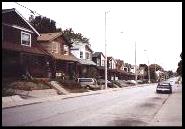
|
|
|
Photos: Alan Walks |


|
Alan Walks, Ph.D., Professor of Urban Geography and Planning, University of Toronto |



|
Current and Ongoing Research Projects
Principal Investigator: Dr. R. Alan Walks, Geography, University of Toronto
I have a number of concurrent projects underway:
Financialization in Canada: Household Debt, Foreclosures, Socio-Spatial Inequalities
Through the 1960s, 1970s, & early 1980s the average Canadian household carried debts roughly equal to 65 percent of their disposable income. By the second quarter of 2013 the level of indebtedness had reached 165 percent - an increase of 253 percent. This is a profound shift without precedent in Canadian history, and a key articulation of financialization. It has occurred at the same time as a general increase in income inequality, both among households, and among communities. This research is concerned with three overarching questions:
1) How did Canadians become so indebted? What is the role of financial innovation? 2)What is the impact of rising indebtedness on Canadian households and communities, both quantitatively and qualitatively? How does rising indebtedness affect household prosperity, and inequality? How does it affect the geographic patterning of prosperity & inequality? 3) How should government policy address rising indebtedness, and its effects? How might financial innovation be made more equitable?
This research project seeks to uncover: 1) the trajectories & forms of indebtedness among households & communities (neighbourhoods, municipalities, regions), 2) the causes for increasing indebtedness, including the role of local economic restructuring, financial innovation & government policy, 3) the consequences of rising indebtedness on household spending & priorities, bankruptcies, household formation, feelings of control, life expectations, and perceptions of the merits of financial innovations/ policies, 4) the consequences of rising indebtedness for community wealth/revenue generation, in terms of a) shifting residential settlement patterns & municipal service delivery, b) changing geographic distributions of employment and spatial flows of income from interest-bearing investments & capital gains (toward Toronto, etc), 5) the consequences for the spatial organization of housing markets, articulated in the geography of foreclosures & powers-of-sale,and 6) analysis of various financial innovations, policies, and regulations, and the proposal of new innovations/policies to make financial innovation & the geographic distribution of prosperity more socially equitable. Framing this research is the hypothesis that a) Canada's economy has become increasingly dependent on profits & employment from financial channels, b) the effects have a clear socio-spatial structure, and c) this is an important cause of rising inequality at multiple scales, and thus financial innovation/reform can reduce inequality. The goal is to use this research to identify reforms to existing financial products and policies, and to propose new financial innovations, that will enhance social and spatial equity and prosperity.
Automobility and Urban Canada: Politics, Planning, Spatial Mismatch, and Implications for Citizenship
Automobility constitutes an internally-coherent and self-organizing, yet non-linear and path-dependent, economic, political, social and cultural system. It is rooted in the growing importance of the automobile, not only for meeting transportation needs, but also for defining popular culture and social norms, shaping patterns of urban neighbourhood inequality and segregation, constraining urban policy and politics, and potentially (re)producing political ideology. The concept of automobility incorporates elements of auto-dependency, autonomy, freedom, privacy, progress, and mobility, and is said to be one of the key socio-technological institutions through which modernity is organized. To the date, the literature largely remains at an abstract and theoretical level, and is dominated by research conducted in the context of the United Kingdom (UK) and United States (US). The impacts of the growth of automobility have received insufficient empirical attention, and huge gaps remain in the literature. The research program outlined herein thus proposes to fill these gaps through an empirical exploration of the social, political and spatial relationships and inter-connections pertaining to this concept, and in turn strives to offer a Canadian perspective on automobility. The objective is to 1) gain an understanding of the social, political and policy-related processes fuelling, sustaining, and/or limiting expressions of “automobility” in Canada; 2) explore the social and political implications of the Canadian expression of automobility for Canada’s urban residents, including neighbourhood inequality and spatial mismatch effects, implications for constructions of citizenship and ‘otherness’, and the impact of automobility on public policy formation at various scales of government, and 3) to use the empirical research conducted in the Canadian context to re-examine and re-theorize the form, expression and contingencies of automobility in Canada, and to understand the relationship between the growth of automobility, social relations and spatial inequalities, and constructions of citizenship and ideology. The latter includes an understanding of the relationship between automobility and the build up of household debt over the last 30 years, and its consequences for urban Canada. Drs. Paul Hess, Matti Siemiatycki, and Ron Buliung are co-investigators on this project. This project is funded by a standard operating grant from the Social Sciences and Humanities Research Council of Canada.
Causes and Consequences of City and Suburban Neighbourhood Divergence
Residents of neighbourhoods in Canadian cities and suburbs have become more segregated into distinct enclaves, more likely to vote like their neighbours, and less likely to vote similarly to residents of other neighbourhoods. As of yet, the reasons for, and effects of, such a spatial polarization are not well known. It may be that the mix of services, including transportation services and infrastructure, the residential form or municipal location of neighbourhoods, the service and social needs evident in neighbourhoods, and the presence of different levels of access to jobs/employment or to security, is responsible for producing divergent paths. Clearly gentrification of the inner city has had an important effect in driving urban change. This project seeks to uncover the reasons for neighbourhood divergence, and to examine the political and policy preferences of residents of people living in neighbourhoods across Canada. This project involves, among other things, random surveys of residents living in seven Canadian metropolitan regions, as well as interviews with planners and politicians representing different neighbourhoods across Canada, analysis of segregation patterns and the correlates of concentrated wealth and poverty, and analysis of voting patterns and political attitudes as provided by national election surveys and the election data. This project was funded by a grant from the Social Sciences and Humanities Research Council of Canada. While the funding period is over, the results are still being written up in articles and books.
Related to the above, I have also been specifically working on a project looking at gated communities in Canada. Gated communities are becoming increasingly common in the landscape of Canadian cities. What are the implications of this phenomenon? Are the residents of gated communities any different than those living in other communities? Are gated communities growing due to demand for extra security on behalf of Canadians? Do the residents of gated communities experience living in them any differently than if they lived in other communities? Does the growth of gated communities mean greater neighbourhood segregation? Do the residents of gated communities vote any differently than those living elsewhere in Canada? To answer these questions, a random telephone survey of residents in gated and non-gated communities has been conducted in three metropolitan areas in Canada, as well as extensive aggregate analysis of changes occurring within gated communities.
For more information about any of this research, please contact Dr. Walks: Post: Department of Geography, University of Toronto, 3359 Mississauga Rd., Mississauga, ON. L5L1C6 Telephone: 905-828-3932 Email: alan dot walks at utoronto dot ca
|